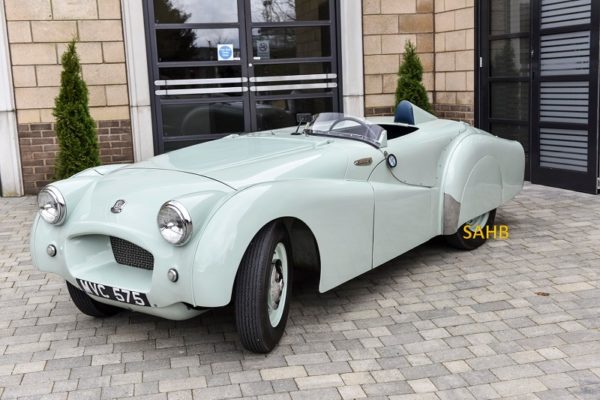
In 1953, Motor Sport magazine reported that, as their June issue closed for press “we learn that the new sports Triumph, with 2-litre Vanguard engine, has distinguished itself by covering the two-way f.s. mile on the Jabbeke Motor Road at 124.095 m.p.h. and the two-way f.s. kilo [sic] at 124.889 m.p.h. driven by Ken Richardson. It ran on Esso fuel and was timed by the Belgian A.C. [RACB] officials. This is a staggering speed for a car the basic price of which is only £555 . . . ”. The issue also carried full-page advertisements heralding the achievement from both Esso and the Standard Motor Company.
The short piece went on to say “We have waited a long time for the sports Triumph to be anything more than an exhibit on show stands . . . but it looks as if the Coventry sports car is well worth waiting for.” By this, W.B. was referring to the firm’s two previous abortive attempts to produce a 2-litre sports car which would change the brand’s image to a more sporty one and contribute to the British car industry’s desperate efforts to recover after the war. The 1950 TR-X had been an elegant, technology-packed design, somewhat similar in appearance to Austin’s A90 Atlantic, and featured seats, windows and convertible top all electrically operated and on-board hydraulic jacks. It would have been prohibitively expensive to build. Instead, it was the 20TS – later to become known as TR1 – which appeared at the 1952 London Motor Show but the two prototypes failed to attract enthusiasm and a damning report by Ken Richardson, Standard Motor Company’s Chief Test Driver, sealed its fate too.
A further year’s work saw the chassis of the 20TS greatly improved, the engine giving a reliable 90 or so bhp and a redesigned body with longer tail and eminently useful boot space and so the TR2 made its debut at Geneva in March 1953. Two months later, Ken Richardson was in Jabbeke, Belgium with one of the prototypes fitted with additional streamlining underneath, over the cockpit and covering the rear wheels. Seated on just a cushion on the floor to aid aerodynamics, Richardson duly achieved the records at what were remarkable speeds at that time for a 2-litre standard sports car and the TR2 became the first in Triumph’s very successful run of sports cars which would continue to the TR8.
The record-breaking car, registered MVC 575, went on to be used as a factory test mule before being sold on, eventually to be acquired in a dismantled and rather dilapidated state by Glen Hewett of Protek Engineering in Wallingford who, once he began restoring it, soon realised the identity and significance of what he had. With the help of some sponsorship from Moss Europe, Hewett completed the restoration to a very high standard, including restoring the car to its original – ‘geranium’ – pale green. A grant of £250,000 from the Heritage Memorial Fund towards the total cost of £280,000 has recently enabled MVC 575 to be purchased by the British Motor Museum at Gaydon where it will go on public display as part of the museum’s extensive collection of British cars, including several other famous world record breakers.
Photo and text by Peter McFadyen. See his website: http://petermcfadyen.co.uk







Leave a Comment